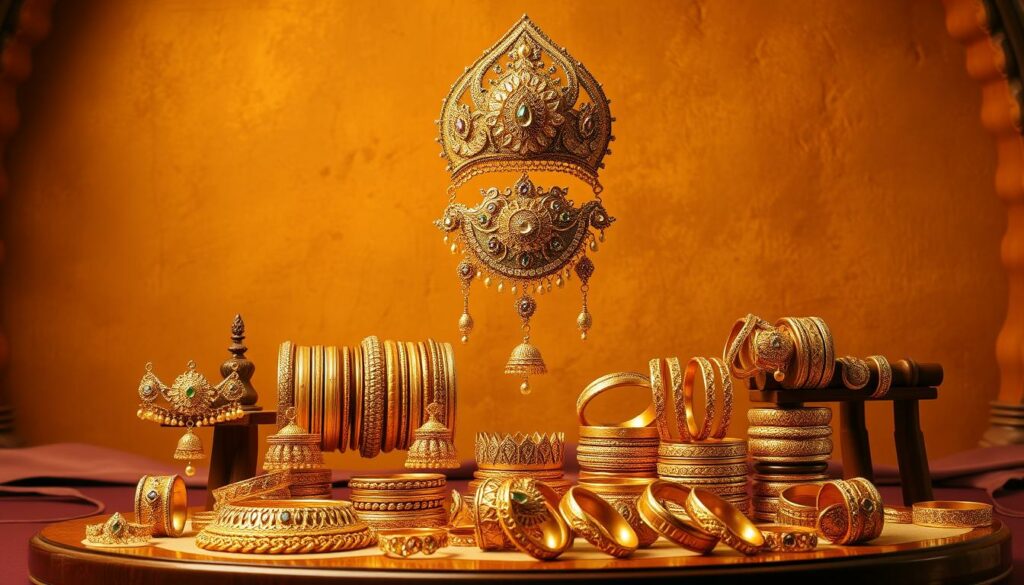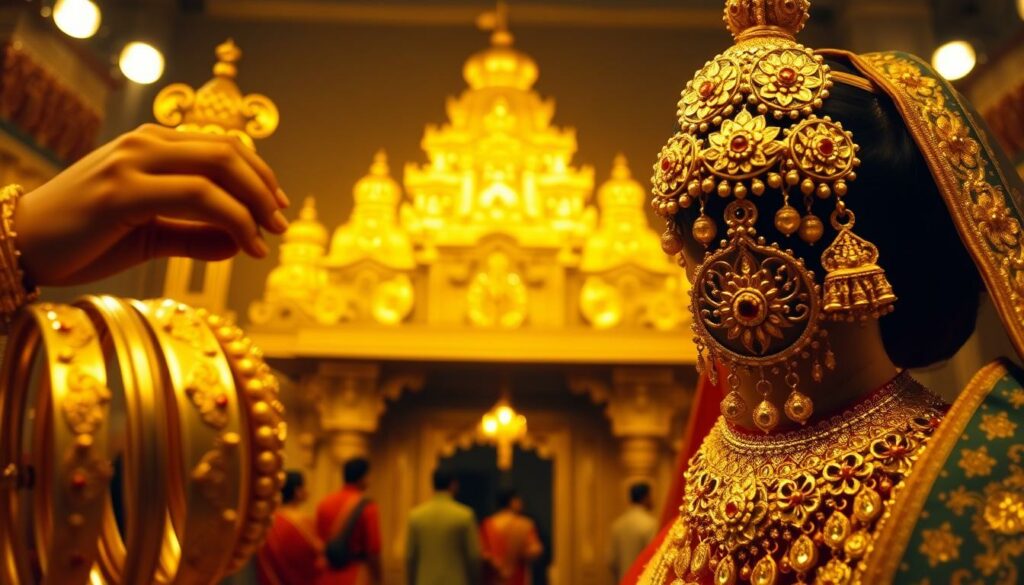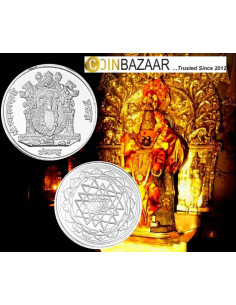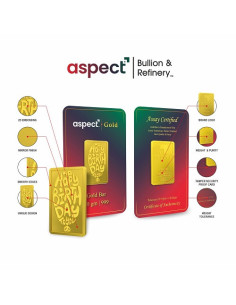Exclusive Deals & Trending Items


BRPL Bangalore Refinery Lakshmi Ganesh Gold Foil Coin Of 2 Grams in 24 Karat 999 Purity / Fineness
Shop Now

Precious Moments Color Shree Gurunanak Dev Ji BIS Hallmarked Silver Coin Of 10 Gram in 999 Purity / Fineness by ACPL
Shop NowGold in Indian weddings is more than just beautiful jewelry. It connects tradition, faith, and family. For centuries, it has symbolized purity, wealth, and blessings.
From the Mangalsutra to intricate Kundan pieces, each gold item has a story. It tells of heritage and hope for the future.
Key Takeaways
- Gold symbolizes prosperity, purity, and marital blessings in Indian traditions.
- Indian wedding jewelry varies regionally, from South Indian temple pieces to North Indian Kundan designs.
- The Mangalsutra, tied by the groom, represents lifelong commitment and cultural pride.
- Heirloom gold jewelry connects generations, blending personal history with modern trends.
- Gold serves as both a sacred ritual item and a secure family investment across India.
The Historical Significance of Gold in Indian Culture
Gold in Indian weddings is not new—it’s a tradition that goes back thousands of years. The Rigveda and Ramayana called gold divine. The word “swarna” means “the best,” showing its sacred value.
In these ancient texts, gold stood for purity and cosmic power. It was linked to rituals, long before weddings became its main use.


Gold moved from temple offerings to wedding symbols over time. Early societies used gold in marital contracts. Families gave gold coins or jewelry during kanyadan, showing a bride’s value.
Today, the mangalsutra—a gold pendant on a sacred thread—keeps this tradition alive. Traditional accessories like jhumkas (bell earrings) and maang tikka (forehead pieces) carry these old meanings.
- Medieval rulers like Mughal emperors blended Persian and Indian designs into bridal jewelry.
- Colonial periods changed production methods but couldn’t erase gold’s cultural core.
- Modern brides still choose gold, merging ancestral patterns with contemporary flair.
Every bangle, necklace, or nose ring has a story. From ancient Indus Valley artifacts to today’s bridal stores, gold connects the past to the present. Its shine is not just beauty—it’s a promise of eternal blessings and continuity.
Gold in Indian Weddings: A Symbol of Prosperity and Blessing
In Indian weddings, gold is more than just jewelry. It’s a symbol of wealth and divine blessings. Bridal gold jewelry is special, believed to bring the blessings of Goddess Lakshmi. Wearing gold jewelry for brides invites blessings for a happy married life.


The mangalsutra, a sacred thread, is tied around the bride’s neck. It’s made of gold beads or pendants. This gold jewelry for brides shows the union’s sanctity and the couple’s shared destiny. Different regions have their own gold jewelry traditions, each with its own meaning.
| Region | Jewelry | Symbolism |
|---|---|---|
| Kerala | Kasu Malai | Gold coins strung together for wealth |
| Rajasthan | Borla Maang Tikka | Studded with gems to signify royal blessings |
| West Bengal | Shakha Pola | Coral and gold bangles for marital harmony |
| Maharashtra | Kolhapuri Saaj | Pearl-adorned necklaces for good fortune |
Gold’s shine is like the sun’s, linking it to fertility and purity. Families buy these pieces for their beauty and as a legacy of blessings. Choosing gold jewelry for brides is more than fashion. It’s a way to welcome Lakshmi’s grace into your new life.
The Religious Significance Behind Gold Jewelry for Indian Brides
Gold in Indian bridal fashion is more than just beauty. It’s a spiritual language. Each piece carries blessings, blending faith and culture. From Hindu mangalsutras to Muslim jhoomars, these adornments hold divine promises.
Hindu Perspectives on Gold in Marriage
In Hindu traditions, gold jewelry traditions in Indian weddings symbolize purity and cosmic energy. The mangalsutra, tied during the ceremony, represents the groom’s vow of protection. Families pass down bridal gold jewelry like temple-inspired rani haar necklaces, blending devotion and heritage.
Even nose rings (nath) honor Goddess Parvati, merging faith with adornment.
Gold Traditions in Muslim Indian Weddings
Muslim weddings see indian wedding jewelry as sacred gifts. The meher, a mandatory wedding gift, often includes gold pieces like forehead paasa ornaments. Bohra brides wear delicate jhoomar headpieces, while Mappila communities favor simple nose rings.
These items symbolize respect and prosperity without compromising Islamic modesty.
Significance in Sikh, Christian, and Other Communities
Sikh ceremonies celebrate equality through gold kadas stacked on wrists during Anand Karaj. Christian brides mix Western rings with traditional jhumkas, creating unique indian bridal fashion. Tribal and Parsi communities add sacred designs like chooda bangles.
These designs show how faith shapes regional gold traditions.
| Community | Key Jewelry | Symbolism |
|---|---|---|
| Hindu | Mangalsutra | Divine marital bond |
| Muslim | Jhoomar | Beauty and blessings |
| Sikh | Kada | Equality in marriage |
Essential Gold Jewelry Pieces Every Indian Bride Wears
Choosing the right gold jewelry for brides is about mixing tradition with personal style. Each piece has its own story, from the sacred mangalsutra to modern bridal gold jewelry designs. Let’s look at the must-haves that make up indian bridal fashion.
The mangalsutra is at the heart of every bride’s look. It’s paired with a gold wedding ring, symbolizing unity and faith. Modern brides prefer simple mangalssutra designs that work for both the ceremony and daily life. Traditional indian wedding accessories like nose rings (nath) and temple-style gold jewelry designs for weddings add cultural touch.
- Necklaces: South Indian kasumala or North India’s kundan styles show regional heritage. Pieces like the Rani Haar or Lakshmi haaram are gold jewelry designs for weddings that shine.
- Earrings & Nose Rings: Statement jhumkas or temple-inspired studs go well with indian wedding jewelry like the Rajasthani nath chains that connect to earrings.
- Bangles & Armlets: Punjabi chuda sets or South Indian gold kada bangles are worn in pairs for luck. Armlets (vanki) add royal elegance.
- Facial Adornments: The maang tikka and forehead matha patti frame the face, completing the bridal look.
Modern brides blend classics with trends. Brands like Manubhai’s Bombay Brides Collection offer designs like the polki necklace (INr 3,26,316) that mix old and new styles. Traditional indian wedding accessories like the haath phool hand jewelry balance with modern gold in indian weddings rituals.
Whether you pick delicate gold jewelry designs for weddings or bold temple pieces, each item has deep meaning. Indian wedding jewelry stores like Indriya make sure pieces last, with lifetime maintenance plans. From bridal gold jewelry sets to personalized rings, every piece becomes a family treasure.
Regional Variations: How Gold Traditions Differ Across India
India’s gold jewelry traditions are as varied as its landscapes. Each state’s bridal sets tell a unique story through design, material, and cultural symbols. From temple-inspired pieces to vibrant kundan masterpieces, exploring these differences shows how geography influences beauty.
- South India: Tamil Nadu’s Oddiyanam—a sacred gold waistband—anchors bridal sets. Kerala’s Kasu Mala, a chain of tiny gold coins, symbolizes wealth. In Karnataka, the Vanki armlet adorns upper arms, while Andhra Pradesh’s Kasulaperu chain drapes elegantly.
- North India: Rajasthan’s Borla maang tikka sparkles with gems, while Punjab’s Haar long necklaces cascade with elegance. Uttar Pradesh’s Thewa pendants blend gold with stained glass artistry.
- West India: Gujarati brides wear Kandora necklaces with pearls, while Maharashtra’s Kolhapuri Saaj combines stones and gold for grandeur. Goa’s Kanzar bangles are paired in sets for festive flair.
- East India: West Bengal’s Shakha Pola coral-and-gold bangles represent marital love. Assam’s Jonbiri earrings and Thuriya floral designs reflect local craftsmanship.
These regional gems—from Odisha’s Rakhis to Manipur’s Khudol—show that Indian wedding jewelry is more than just adornment. It’s a language of heritage, passed down through generations. Whether you choose temple motifs or kundan-studded pieces, your choice celebrates India’s timeless artistry and reflects your roots.
Gold Beyond Adornment: Its Role in Wedding Rituals and Ceremonies
Gold in Indian weddings is more than just beauty. It witnesses sacred moments. After the main ceremony, it plays a deeper role in rituals that unite families and traditions. Imagine starting a new home with a plate of rice and gold coins, symbolizing wealth. This is the grihapravesh, marking the bride’s new life.
During bidai, the emotional farewell, a bride gets gold jewelry from her mother. It’s not just a gift—it’s a lifelong bond. In South India, a gold thali is blessed before the groom ties it, blending faith and tradition. After the wedding, families give gold pieces, each with its own story.
- Regional customs: In Punjab, toe rings (bichhua) become mandatory post-wedding, signaling marital status.
- Symbolic changes: Some brides switch to heavier mangalsutra designs after the wedding, reflecting their new role.
- Timing matters: Gold gifted during festivals like Navratri post-marriage reinforces family ties and blessings.
“Every grain of gold in a bride’s jewelry is a thread weaving her past, present, and future,” says cultural historian Dr. Anika Mehta.
Gold jewelry traditions in Indian weddings also guide when pieces are first worn. A kamarband (waistband) might wait until the saat phere, while nose rings (nath) are sometimes reserved for the post-wedding graha pravesh ritual. Even lightweight gold designs for brides adapt to modern lifestyles without losing their ritual significance. From kundan styles in Rajasthan to jhumkas in Bengal, each design tells a story of heritage.
These practices ensure gold isn’t just worn—it’s lived. Whether it’s a simple chain gifted during saat phere or intricate jhumkas at post-wedding gatherings, every piece celebrates unity and continuity.
The Economic Perspective: Gold as Investment and Security
For Indian families, gold in Indian weddings is more than a tradition—it’s a smart financial choice. Bridal gold jewelry serves as a financial safety net. The tradition of streedhan ensures the bride keeps her gold, giving her financial freedom for life.
This practice has a long history, helping women in societies with limited inheritance rights. Today, it’s practical: gold’s value holds up during tough times.
“India holds 11-13 million weddings annually, driving its status as the world’s largest gold jewellery market,” says the World Gold Council. Over 65% of India’s population under 35 fuels this demand, with bridal jewelry alone claiming 50-55% of sales.
Today, families mix tradition with new ideas. While gold jewelry for brides is still key, many explore gold ETFs or sovereign gold bonds for better returns. These options let families invest in something liquid and low-maintenance, while still respecting their culture.
The average 25g+ gold purchase per bride still holds value. Gold’s role as collateral in rural areas or its use as an inflation hedge makes it essential.
- Gold ETFs track market prices without physical storage needs
- Sovereign Gold Bonds offer interest and tax benefits
- Digital gold platforms allow easy trading and liquidity
Even as gold wedding trends in india change, gold’s core role remains: securing a bride’s future. With 16% of Indian household wealth in gold, it’s both a tradition and a smart financial move. Whether through classic bridal gold jewelry or modern investments, it’s a timeless strategy for families.
How to Choose the Right Gold Jewelry for Your Indian Wedding
Choosing the perfect gold jewelry designs for weddings begins with knowing your indian bridal fashion style. Match your jewelry to your outfit’s color and style. Gold looks great with bright lehenga colors like red or maroon. White or ivory gowns are perfect for diamond-studded pieces.
For high necklines, go for chokers. Long necklaces work best with deep necklines.
- Pair heavy necklaces with simple earrings like studs or small drops to balance your look.
- Choose comfortable pieces—avoid overly heavy designs that may strain during long ceremonies.
- Incorporate heirlooms or customize jewelry to blend tradition with personal taste.
Traditional pieces like maang tikka, kadas, and naths add cultural depth. For example, the Hana Diamond Stud Earrings (INr 19,000–68,000) or the Pansy Blossom Pearl Chand Bali offer timeless styles. The Aliya Infinity Diamond Mangalsutra is a versatile option that works for both ceremonies and daily wear.
- Stick to your budget by prioritizing quality craftsmanship and hallmark authenticity.
- Gold bangles like the Round Geo Diamond Bangle and Twiz Diamond Bangle balance tradition and elegance.
Mix regional trends with your personal style—whether it’s intricate kundan designs or modern minimalist pieces. Focus on comfort, cultural relevance, and pieces that show off your unique style.
Modern Trends: How Today’s Brides Are Redefining Gold Wedding Jewelry
Indian brides are mixing old traditions with new styles. They’re making gold wedding trends in india their own, showing off their unique taste. Now, you see everything from changeable mangalsutras to pieces in different colors.
Designers like Manish Malhotra are leading the way. They blend traditional filigree with modern shapes. Pendants turn into chokers, and old designs get a sleek makeover. “Our jewelry should honor our roots but also feel new,” Malhotra says.
Today’s brides want that’s versatile. They look for pieces that can go from the wedding to a night out. Think adjustable chains or earrings that can be worn in different ways.
- Rose gold mangalsutras with diamond clusters
- Lightweight hollow-core necklaces mimicking heirloom scale
- White gold temple motifs paired with palladium accents
“A mangalsutra can now be a reversible pendant—traditional by day, modern by night.” — Luxury designer Anjana Khanna
Now, there are lighter, yet grand, pieces thanks to 3D printing. Brides also love mixing metals, like pairing rose gold with yellow gold. Even gemstones are getting a modern twist, with unique cuts and inlays.
With over 300,000 jewelers offering these options, you can find something that fits your style. Whether it’s a tassel necklace or rose gold rings, keep tradition alive and exciting.
Family Heirlooms: The Tradition of Passing Down Wedding Gold
Family heirlooms are more than gold jewelry traditions in Indian weddings. They connect generations. A mangalsutra from your great-grandmother or a polki necklace from the 1950s tells stories of strength.
These pieces are not just indian wedding jewelry. They are living history, mixing traditional Indian wedding accessories with beauty.
Every heirloom has a story. Kundan jewelry, with its bright colors, might come from a royal family. A filigree bangle from Karnataka, as delicate as lace, could have been worn in 1947.
These designs show rare craftsmanship, making them priceless. Imagine a pearl set passed through five generations. Its shine reminds you of your grandmother’s wedding gold jewelry designs for weddings.
- Preserve: Store heirlooms in velvet boxes. Use anti-tarnish pouches to prevent damage.
- Protect: Take pieces to skilled artisans for repairs using traditional methods, not modern substitutes.
- Document: Note the piece’s history—when it was made, who wore it. This turns it into a family treasure.
Style heirlooms creatively. Pair a vintage temple jewelry piece with modern gold jewelry for brides. Turn a bracelet into a necklace, or pin heirloom pendants on your lehenga. Even a small heirloom brooch in your bouquet honors tradition without overwhelming modern indian bridal fashion.
These pieces are not just gold—they’re legacies. Wearing them connects you to ancestors who protected these treasures. With care, your great-granddaughter will admire your mangalssutra, just as you cherish your grandmother’s.
The Emotional Connection: Why Gold Jewelry Holds Sentimental Value
Gold in Indian weddings is more than just sparkle. It’s a language of love and memory. When you wear your mangalsutra or a family heirloom necklace, you carry more than gold jewelry for brides. Each piece connects you to moments, people, and promises.
Think of your grandmother’s gold waistband, passed down for years. Its engravings might hold the initials of generations. Or its design could mirror your great-aunt’s patterns. This is heritage in metal. A mangalsutra from your partner? It’s a physical promise of commitment, a talisman for life’s ups and downs.
- Family Bonds: Gold pieces often come as gifts, tying you to the hands that gave them.
- Memory Keepers: A pair of jhumkas might remind you of your wedding day’s laughter or your mother’s tears.
- Identity: The intricate craftsmanship mirrors India’s traditions, making you feel connected to your roots.
“My mangalsutra isn’t just jewelry—it’s the day I became someone’s wife, forever etched in gold.”
Even in tough times, gold jewelry offers comfort. A widow might wear her late husband’s bangles as a quiet prayer. A separated couple might still cherish their matching rings as reminders of shared vows. Gold’s durability keeps these stories alive, even as trends change. Next time you wear a necklace, remember: it’s not just gold in indian weddings—it’s a story waiting to be told.
Gold Care Guide: Maintaining Your Wedding Jewelry for Generations
Keeping bridal gold jewelry beautiful is key. Clean your gold jewelry designs for weddings gently after each use. This stops oils and makeup from building up.
- Soak in warm water mixed with mild dish soap for 15–20 minutes.
- Use a soft toothbrush to scrub traditional indian wedding accessories like mangalsutra or kundan.
- Avoid ammonia-based cleaners near gemstones; use a damp cloth for jadau jewelry.
- Rinse with lukewarm water and pat dry with a microfiber cloth.
Storage Tips:
- Wrap gold jewelry for brides in individual cloth pouches to prevent tangling.
- Place diamond pieces in velvet-lined boxes with silica gel packets to absorb moisture.
- Store indian wedding jewelry in separate compartments to avoid scratches.
| Type | Cleaning | Storage |
|---|---|---|
| Plain gold bangles | Soap water soak | Cotton-lined boxes |
| Gemstone necklaces | Soft-brush cleaning | Plastic airtight containers |
| Pearl earrings | Warm water wipe | Individual silk pouches |
Have gold in indian weddings pieces checked by experts every 2 years. Look for signs like loose prongs or dull finishes. For valuable items, get them insured. Update the value every 3–5 years with a gemologist.
Ethical Considerations: Sourcing Sustainable and Conflict-Free Gold
Choosing gold for your wedding doesn’t have to harm the planet or human rights. As gold wedding trends in india change, many couples look for ethical options. They want to keep traditional values but also care for the environment.
- Look for Fairtrade Gold or Fairmined certifications to ensure safe labor practices.
- Opt for recycled gold—brands like Lebrusan Studio craft 22ct recycled pieces, blending ethics with tradition.
- Ask jewelers about supply chains; transparency matters.
“Recycled gold lets you keep cultural symbols without harming nature,” says Lebrusan Studio. Even small choices help: using vintage items or lab-grown stones cuts down on mining. Remember, 24ct gold can still be sourced ethically. By choosing sustainable options, you celebrate tradition while staying true to your values.
Planning Your Wedding Gold Budget: Tips and Considerations
Planning for gold jewelry traditions in indian weddings means balancing old customs with new budgeting. First, learn about the gold jewelry needed in your area. For example, South Indian weddings love detailed gold jewelry designs for weddings. Punjabi weddings, on the other hand, focus on big statement necklaces.
Make a list of all the indian wedding jewelry your family expects. This will help you plan better.
Use a spreadsheet to keep track of each piece’s cost. Start with the most important items like mangalsutras or nose rings. For gold wedding trends in india, look into lighter designs or mixed metals for less important pieces.
Try to save money by negotiating with jewelers during slow times. You can save up to 10–15%. Remember, 20–30% of your wedding budget should go to jewelry.
- Research regional requirements (e.g., Mysore-style temple jewelry vs. Rajasthani meenakari)
- Set aside 10% of your budget as a contingency fund
- Compare quotes from at least three jewelers
- Consider staggered purchases—buy essential items early, then add decorative pieces later
Timing is key: Buy main pieces 6–8 months before the wedding to avoid high prices. For bridal gold jewelry, finalize designs 4–6 months before to get them on time. Always ask about maintenance to keep your jewelry lasting long.
With smart planning, you can follow traditions without breaking the bank.
Conclusion: Embracing the Golden Tradition in Your Wedding Journey
Gold in Indian weddings is more than just jewelry—it’s a celebration of heritage and love. Each piece, from traditional mangalsutras to modern rose gold designs, holds centuries of symbolism. Your choices show both your roots and personal style, mixing old with new.
Family heirlooms and sustainable options like recycled gold connect you to your ancestors while shaping your future. These pieces are more than just decorations; they’re bridges between generations, symbolizing prosperity and unity. Whether you choose South Indian temple-inspired styles or North Indian Kundan, your gold jewelry becomes a living tradition.
Remember, gold’s role is more than its beauty—it’s an investment in your legacy. By picking pieces with care, you honor cultural values and create a story that’s uniquely yours. Let your Indian wedding jewelry shine as a promise of continuity, linking past blessings to your future. Every piece you choose becomes part of a timeless story, ensuring your wedding’s gold remains a cherished heirloom for generations.


















